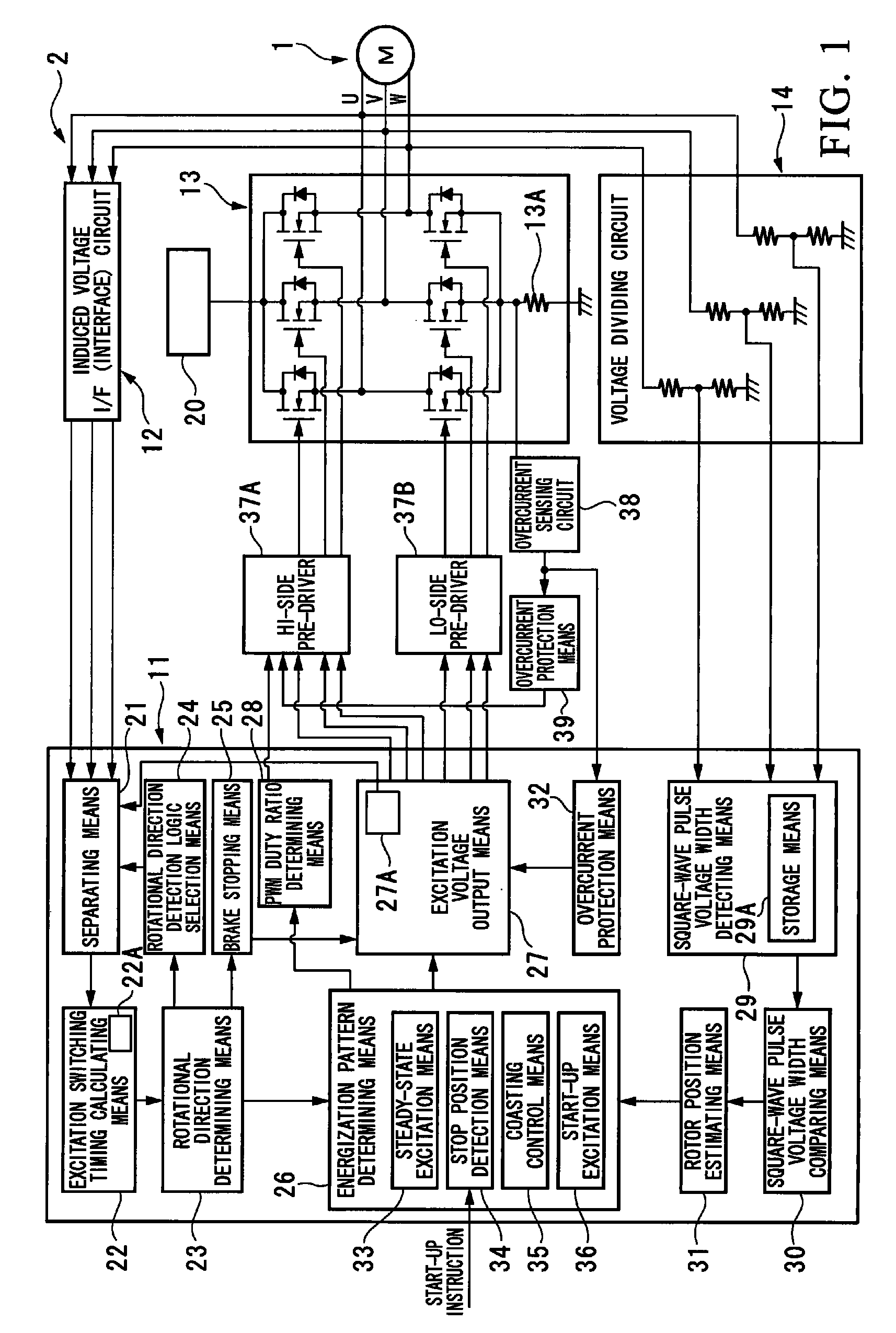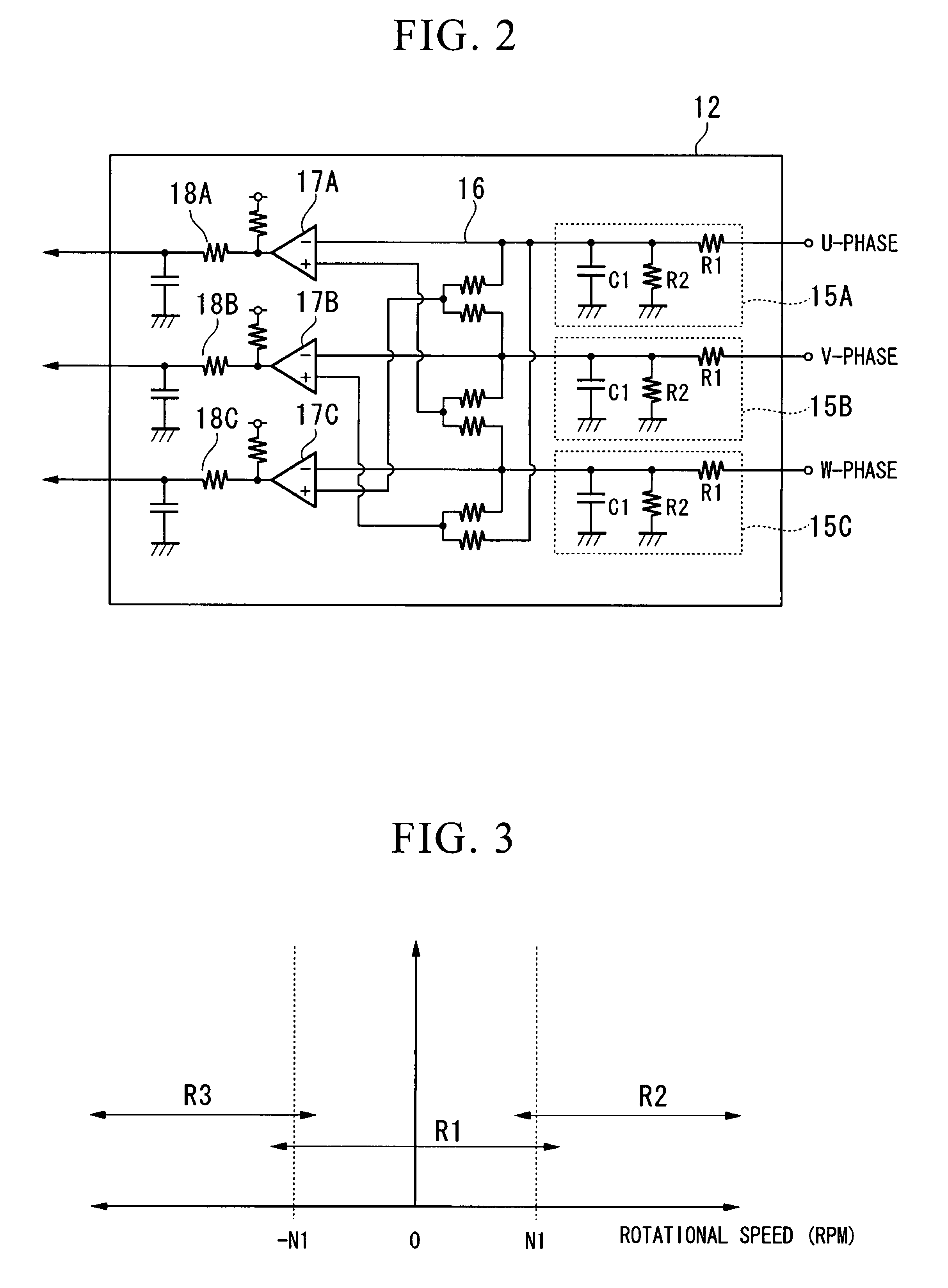Brushless motor driving device, brushless motor starting method, and method of detecting rotor stop position of brushless motor
a brushless motor and driving device technology, applied in the direction of motor/generator/converter stopper, electronic commutator, dynamo-electric converter control, etc., can solve the problem of affecting the constitution of the device, affecting the accuracy of the determination, and not having the signal sufficient for the detection of the rotational position. , to achieve the effect of eliminating complicated processing and accurately detecting the rotor position
- Summary
- Abstract
- Description
- Claims
- Application Information
AI Technical Summary
Benefits of technology
Problems solved by technology
Method used
Image
Examples
first embodiment
[0074]As shown in FIG. 1, a brushless motor system has a brushless motor 1 and a driving device 2 that controls the rotational driving of the brushless motor 1.
[0075]The brushless motor 1 has a rotor that has permanent magnet and a stator. In the stator, coils of three phases (U, V, W) are wound in that order in the circumferential direction. This brushless motor system is a sensor-less type system that does not have a sensor that detects the rotor position.
[0076]The driving device 2 has a control unit 11 which is formed of microcomputers and the like, an induced voltage I / F (interface) circuit 12 that detects the voltage that is impressed on the current-carrying wires that form the coils of three phases of the brushless motor 1, an inverter 13, and a voltage dividing circuit 14 that is a level conversion circuit that converts the level of the voltage that is impressed on the current-carrying wires of the brushless motor 1, in which pre-drivers 37A and 37B, an overcurrent sensing ci...
second embodiment
[0182]This embodiment uses reverse rotation specific logic in addition to forward rotation specific logic. The constitution of the apparatus is identical to that of the first embodiment.
[0183]FIG. 19 is a flowchart of operation during start-up. In the flowchart, the processing from step S101 to step S108, that is, the processing when the rotational speed of the brushless motor 1 during start-up initiation is in region R1 or region R2 of FIG. 3, is identical to the first embodiment. When the rotational speed during start-up is in region R3, the processing proceeds from step S108 to step S110A.
[0184]In step S110A, the rotor position is detected by detecting the induced voltage using the reverse rotation specific logic. The reverse rotation specific logic is selected by the rotational direction detection logic selection device 24 in the case of the rotational direction determining device 23 determining that the brushless motor 1 is rotating in reverse. The reverse rotation specific log...
third embodiment
[0188]This embodiment initially performs a brake process.
[0189]As shown in FIG. 20, after the overflow current detection process is performed (step S101), a two-phase energization lock process is performed at a low duty ratio (step S102A). The brake time is a prescribed time (step S102B). These processes are processes that correspond to steps S111 and S112 in the first embodiment. During start-up, even when the rotational speed of the brushless motor 1 is in any of regions R1 to R3; it is forcibly controlled to region R1 by the brake process. The subsequent processes are the same as the first embodiment.
[0190]Also, as shown in FIG. 21, even when using the reverse rotation specific logic (corresponding step S110A), by initially performing a brake process in steps S102A and S102B, even when the rotational speed of the brushless motor 1 is in any of regions R1 to R3, the rotational speed is forcibly controlled to region R1 by the brake process.
[0191]While preferred embodiments of the i...
PUM
 Login to View More
Login to View More Abstract
Description
Claims
Application Information
 Login to View More
Login to View More - R&D
- Intellectual Property
- Life Sciences
- Materials
- Tech Scout
- Unparalleled Data Quality
- Higher Quality Content
- 60% Fewer Hallucinations
Browse by: Latest US Patents, China's latest patents, Technical Efficacy Thesaurus, Application Domain, Technology Topic, Popular Technical Reports.
© 2025 PatSnap. All rights reserved.Legal|Privacy policy|Modern Slavery Act Transparency Statement|Sitemap|About US| Contact US: help@patsnap.com



